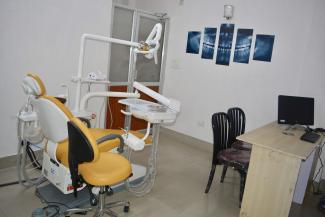Orthodontic Treatment
A) BRACES FOR KIDS
Why and When ??
The American Association of Orthodontists recommends that all children should have an orthodontic screening by the age of 7.
Things have changed since the past two decades, where going to the orthodontist probably wasn’t mentioned until you had all your permanent teeth (12 to 13 years). When you finally went to the orthodontist you might have had teeth extracted because there was not enough room for all of them or there was a need to wear braces for a long period of time. Treatment usually starts later but accurate timing is essential. This is possible only if the child is already under the expert’s care and observation. Since girls mature earlier, treatment may start at the age of 8 to 10 years while a boy may be treated at 10 to 11 years of age or even later.
Why do you need ‘Early Orthodontic’ screening?
Dr Shrawan Kr Sharma emphasizes on early orthodontic screening and treatment as Children can benefit enormously from an early phase of treatment, while they are growing actively during early growth spurts. During this period the children have mixed dentition (few milk teeth as well as some permanent teeth present in the mouth).
Special appliances can be used at this stage to influence the growth relationship of the jaws themselves. (This is not possible when all the permanent teeth have already erupted into the mouth).
Latest techniques and modern Orthodontic Appliances have made it even easier to treat younger patients, with safe and painless growth modifying appliances.
Prevention is better than cure.
Advantages of Early Treatment (also called as Phase I treatment)
Minimizes need for tooth extraction.
In a large number of patients a successful Phase I treatment ensures that all permanent teeth get accommodated and more often there is no need to extract permanent teeth at a later stage for creating space.
Protection of protruding front teeth from damage and trauma.
Front teeth that protrude forward are likely to get injured leading to severe dental trauma. (Broken/chipped teeth may require specialized treatment i.e. root canal treatment). Early orthodontic treatment corrects such teeth rapidly thereby prevents permanent damage.
Aesthetic and functional development in early years.
Patients can get rid of their buck-toothed, bunny-rabbit appearance. This tremendous facial improvement is always accompanied by wonderful personality change. Thus, there is not only a dental but also a mental advantage too. These conditions go unnoticed if you wait till 12 years of age.
b) ADULT ORTHODONTIC
Adult Orthodontic – it’s Our Specialty
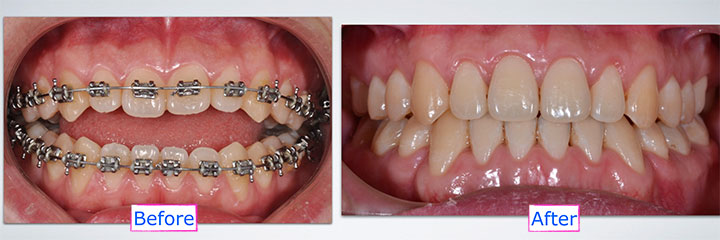
GOOD NEWS – BRACES FOR ALL AGE GROUPS
With the latest advances and technologies, it is now possible to treat young children, young adults and older adults for orthodontic (braces) treatment, hence making it possible for them to enjoy good function and esthetics.
Most orthodontists have experienced an increase in the number of adult patients in the past few years. This has undoubtedly been due to increased experience with adult orthodontic treatment and the achievement of good results, increased public awareness of the possibilities of adult treatment.
We have treated about 2000 adult patients successfully with orthodontic treatment at our clinic.
Innovations in appliances and tooth-colored wires and brackets
Innovations in appliances – especially the advent of direct bonding, and less visible brackets and tooth-colored wires- have caught the attention of many adults who would not otherwise seek orthodontic treatment. The recent development is lingual orthodontics or invisible orthodontics, have further motivated them. There is always a misconception regarding treatment timing, but best braces can make treatment timing from six months to two years depending upon severity of problems. Age is a factor that should be taken into consideration, but results are usually gratifying even in patients of advanced age.
We are specialists in adult Orthodontics & have almost 60% patients of our total patient number as adult patients.More than 2000 adult patients happily underwent braces treatment with invisible new advance system of braces.
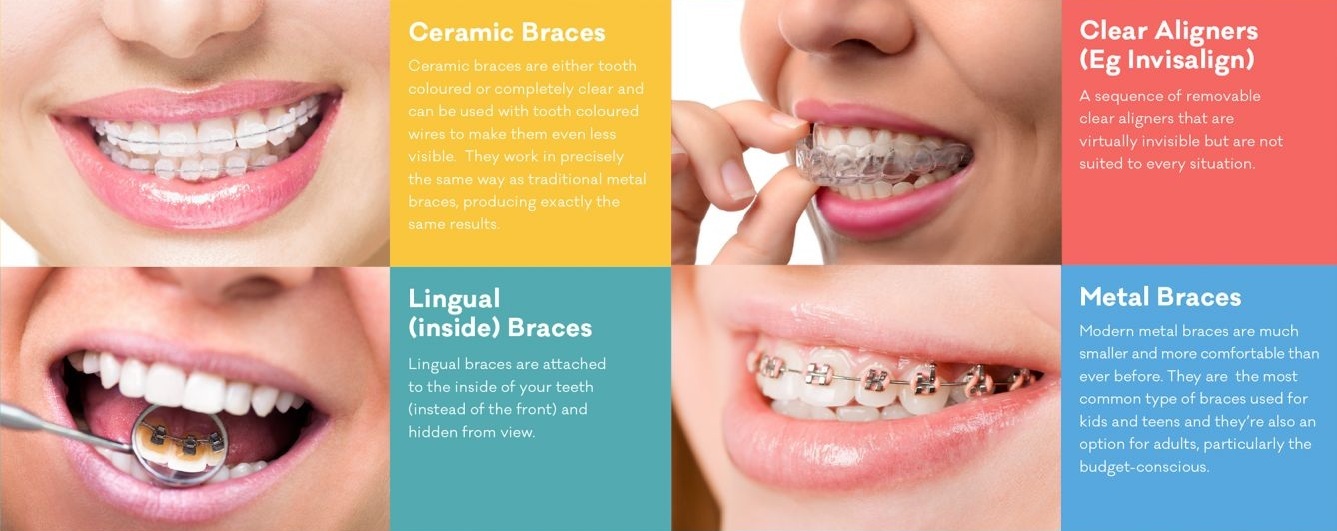
Implant Orthodontic
A newer technique in order to reduce treatment timing in adult patients. Here instead of molar teeth the bone is used as the anchor area with mini implant, which dramatically reduces friction between braces & wire and moves teeth at faster rate, thereby further reducing treatment time. We have treated a number of cases with this painless technique delivering best results.
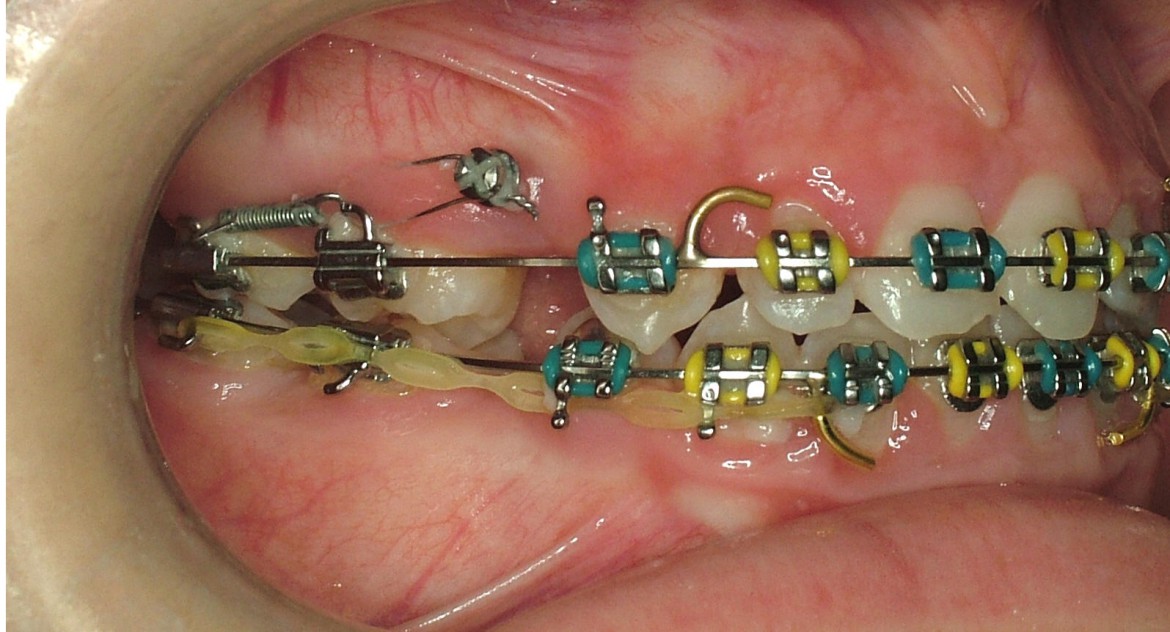
c) INVISALIGN

Do you want to straighten your teeth without the metal braces showing?
Are you worried about the metallic smile while going through the braces (orthodontic) treatment?
WHAT IS INVISALIGN?
The Invisalign technique takes a modern approach towards straightening teeth, using a custom-made series of aligners created especially for you. These aligner trays are made of smooth, comfortable and virtually invisible plastic that you wear over your teeth.
There are neither any metal brackets to attach or any wires to tighten.
HOW DO THEY WORK?
Wearing invisaling aligners will gradually and gently shift your teeth into right place, based on the exact movements that we plan out for you. Just pop in a new set of aligners approximately every two weeks, until your treatment is complete.
You’ll achieve a great smile with little interference in your daily life. The best part about the whole process is that most people won’t even know you’re straightening your teeth.
Invisalign mean you can keep your appearance attractive Other people will hardly notice you are wearing a splint, because the splint is transparent and smooth, without any screws or brackets. Even during the treatment, you will be able to talk and laugh without impediment because the transparent material means that the ALIGNER splint is barely visible.
Pleasantly smooth and comfortable The Invisalign splint guarantees you a good, almost familiar feeling to your mouth. When you wear it, you will notice how pleasantly smooth and comfortable it is because it does not need screws or wires. When eating or cleaning your teeth or splint, you can simply take it out – quick and easy, whenever you like.
TRANSPARENT
The Invisalign splint is clear and transparent; almost Invisible You can talk and laugh without restrictions or impediment.
COMFORTABLE
The high-quality splint makes your mouth feel good. It is pleasantly smooth, with no screws or wires.
REMOVABLE
You can take the splint out at any time and put it in again quickly and easily, e.g. when eating or cleaning.
HYGIENIC
You can easily keep the Invisalign splint clean, e.g. using toothpaste and toothbrush.
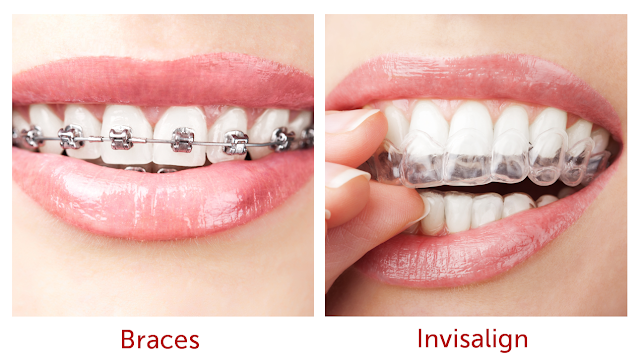
d) POWER BRACES
Power braces – Quick Orthodontics
Have you considered orthodontics or teeth straightening treatment, but have been put off by the possibility of wearing braces for 18 to 24 months?
If yes, There is answer for those wanting quick fixed treatment for a perfect smile for various occasions like on your wedding by not compromising the health of your NATURAL TEETH – the revolutionary 4-8 Month Smiles treatment. (This treatment gives you your Natural Smile, although is not an alternative to comprehensive, complete orthodontic treatment when indicated, but a very good option for people who want a quick fix without the need of grinding your sound teeth or damaging the Natural Enamel of your teeth). The newer self-ligating frictionless braces are fast and painless and are quick to give results in simple cases
This treatment can be used to treat a wide variety of orthodontic complaints related to the front six teeth which are seen when you smile, like: mild crooked teeth, Spacing – gaps between teeth, Overjet – front teeth stick out, Crossbite – teeth bite on the wrong side of each other. This treatment indicated in limited cases & the final decision to treat you with Power orthodontics is sole decision of your orthodontist.
- INVISIBLE BRACES
- CERAMIC BRACES
- INVISALIGN
- SELF LIGATING
e) SURGICAL ORTHODONTICS
WORKING TOGETHER FOR YOU
In the treatment of dental abnormalities, bad bites (malocclusion) and crooked teeth are usually corrected by an orthodontist.
Abnormalities of the jaw are usually corrected by an oral and maxillofacial surgeon. When both conditions exist, it is common to find an orthodontist and oral surgeon working together to correct the deformity.
This collaborative approach to the complex dental / facial problems is ensured to provide better oral health for thousands of adults and children. These thousands are rewarded with straight teeth, bright smiles and facial symmetry – a beauty of shape, form and position.
What treatment is used?
Most orthodontic patients undergo an initial period of orthodontic treatment to align the teeth-(anywhere between 4 to 12 months) – so that they will align properly after surgery is completed. Surgery usually is not scheduled until the teeth have been properly aligned.
Orthodontic appliances used to align teeth prior to surgery are left in place during the surgical procedure to aid in stabilizing the teeth and jawbones. After surgery there is a period of follow-up orthodontic treatment to achieve final alignment of the teeth, thus complementing the new facial symmetry.
Can surgery be avoided?
In younger patients, future facial growth combined with timely orthodontic intervention can sometimes correct protrusion and/or retrusions of the jawbone. An orthodontist working with children as young as age 7 can use one of several orthodontic appliances to direct bone growth, thus eliminating the need for surgery in some patients. However, in adults, and those patients who have completed their bone growth, the improper tooth/bone relationship is frequently treated with surgery.
Are there any risks?
The portion of surgical orthodontic treatment provided by an oral surgeon entails the usual risks inherent with any type of surgery.
However, surgical orthodontic procedures are not new or experimental; they are routinely performed in dental offices or hospitals on a regular basis. If you or a member of your family are about to undergo surgical orthodontic treatment, your oral surgeon would explain the risks, to set your mind at ease.
What are the rewards?
Following completion of the surgical orthodontic process, dental health is improved – no bad bites or crooked teeth. The jawbones and profile relationships are also more stable, functional and aesthetic. Facial appearance is improved.
THE MOST LASTING REWARD IS A MORE BEAUTIFUL, HEALTHIER AND HAPPIER YOU!
What problems does surgical orthodontics best correct ?
There are a wide variety of causes of jawbone discrepancies – heredity, trauma or other developmental problems. Most commonly corrected problems include:
- The protruding or detruding chin.
- Gummy smile.
- Severe upper and lower teeth protrusion.
- Overall elongation of face.

